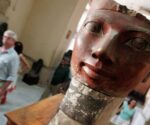Archaeology breakthrough as 9,000-year-old bombshell found in major city | World | News
Archaeologists have uncovered a remarkable 9,000-year-old discovery buried within a major ancient city, one that could reshape our understanding of the origins of civilisation. The study, conducted by researchers from the University of Wollongong’s School of Science in Australia, has been published in Science. It comes days after a group of scientists revealed the face of Egypt’s forgotten female Pharaoh in a huge breakthrough.
In the study, researchers examined ancient DNA extracted from nearly 400 skeletal remains found at Çatalhöyük- a remarkably well-preserved Neolithic site located in southern Turkey. The findings pointed to compelling evidence that this early civilisation may have been structured around maternal lineage, hinting at the possibility of a matriarchal social system.
Çatalhöyük is one of the most fascinating archaeological sites in the world. It is a 9,000-year-old Neolithic settlement in southern Turkey that is reshaping our understanding of early human civilization.
The DNA analysis suggests that women were buried with far more grave goods than men, and that daughters stayed with their maternal households, while sons often left, reports Mail Online.
A multidisciplinary team of geneticists, archaeologists, and biological anthropologists successfully extracted DNA from the remains of over 130 individuals buried beneath the floors of 35 distinct homes at the Çatalhöyük site.
Close to 400 burials have been uncovered at this once-thriving Neolithic settlement, which flourished for over a millennium.
Burial patterns revealed that women and their daughters were routinely interred together, whereas men appeared to originate from other areas-implying they joined their wives’ households through marriage.
Researchers estimate that between 70 and 100 % of female descendants remained within their maternal family homes over successive generations, while males typically relocated elsewhere.
Dr. Eline Schotsmans, a co-author of the study and research fellow at the University of Wollongong’s School of Science in Australia, encouraged contemporary society to challenge long-standing misconceptions about gender roles in ancient civilisations.
Benjamin Arbuckle, an archaeologist at the University of North Carolina at Chapel Hill who was not involved in the study, wrote in a perspective in Science that “if the sex patterns were reversed, there would likely be little hesitation in concluding that patriarchal power structures were at play.
“This is reflective of the difficulty that many scholars have in imagining a world characterised by substantial female power despite abundant archaeological, historic, and ethnographic evidence that matriarchal fields of power were and are widespread.”









